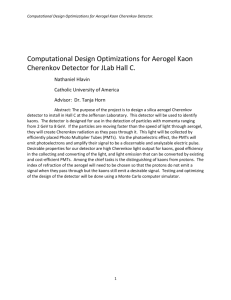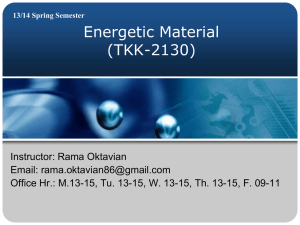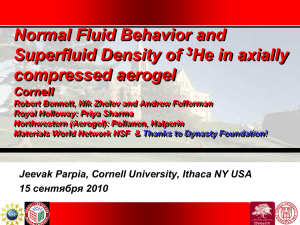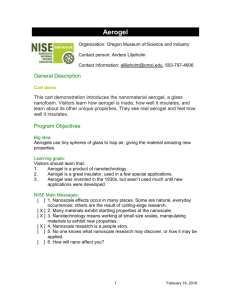presentation_a_barnyakovATC
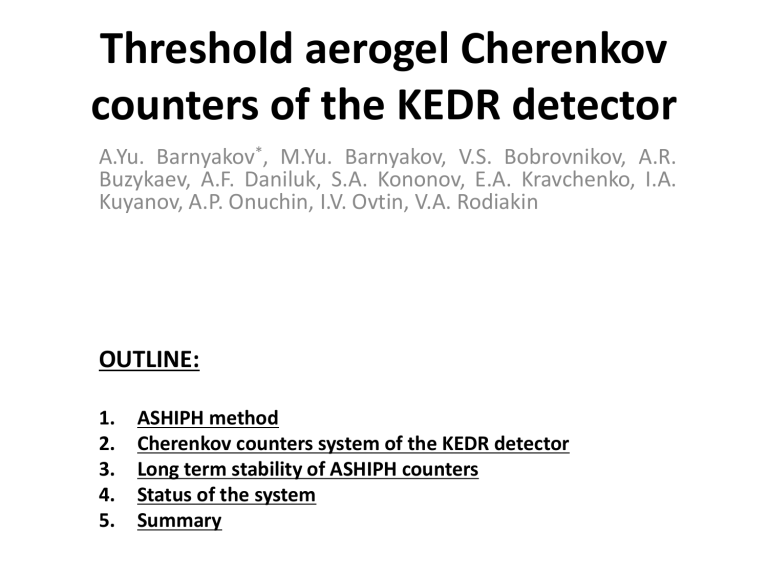
Threshold aerogel Cherenkov counters of the KEDR detector
A.Yu. Barnyakov * , M.Yu. Barnyakov, V.S. Bobrovnikov, A.R.
Buzykaev, A.F. Daniluk, S.A. Kononov, E.A. Kravchenko, I.A.
Kuyanov, A.P. Onuchin, I.V. Ovtin, V.A. Rodiakin
OUTLINE:
1.
ASHIPH method
2.
Cherenkov counters system of the KEDR detector
3.
Long term stability of ASHIPH counters
4.
Status of the system
5.
Summary
ASHIPH method
• Development of aerogel counters in Novosibirsk was started in 1986 by collaboration of BINP and BIC for creation of threshold Cherenkov counters. Now this collaboration is working on the development of RICH detectors based on aerogel radiators( details on FARICH in oral presentation of S.
Kononov )
• In 1988 first project of aerogel Cherenkov threshold counters for the KEDR detector with direct light collection was suggested (A. Onuchin et al., World
Scientific, 1990, 208-213)
• ASHIPH (Aerogel SHifter PHotomultiplier) method of light collection was suggested in 1992. Cherenkov light from aerogel is collected by wavelength shifter (WLS) and transported by WLS like a lightguide to photomultiplier photocathode (A. Onuchin et al. NIM A315 (1992) 517-520)
– This method permits to decrease photocathode area
– This method permits to make very compact valuable PID system in
HEP experiments (ex. Aerogel counters for SND detector, more details on the system in two posters: K. Beloborodov and K. Martin )
26.02.14
INSTR14 2
The system of ASHIPH counters for the KEDR detector
• 160 counters arranged in 2 layers
• 96% of solid angel
• 1000 liters of aerogel with n=1.05
• π/K- separation in momentum range 0.6-
1.5GeV/c
• Light collection with help of WLS
• 160 MCP PMTs with photocathode ø18mm able to work in magnetic field up to 2T
• Thickness of the material is 12%X
0
INSTR14 3 26.02.14
0.08
0.1
K
Prototype testbeam results
P=1.2GeV/c
Estimation for 2 layers system: p p
80% of particles from interaction point goes through aerogel in both layers
0.06
0.04
0.02
Counter with blocks with crumb
0
0 1
P,
GeV/c
Pion supp. factor
0.86
900
2 3
Threshold, pe
Kaon reg. eff.
4 5
Separation
94%
4.7
4.5
26.02.14
INSTR14
P,
GeV/c
0.86
1.2
Pion supp. factor
8.1
10 5
1.69
10 6
Kaon reg. eff.
88%
81%
Separation
5.9σ
5.7σ
4
10
9
8
7
Long term stability
• 80 counters (1 st layer of the system) were under operation in the KEDR detector from
2003 to 2011. Approximately 3.5 years of operation in magnetic field 0.6T.
• 17 counters were non operational due to drops of magnetic field. All barrel counters had efficiency worse than expected.
6
ATC efficiency in KEDR (BhaBha events)
5
4
1
10
3
2
1
P1
P2
P3
39.41 / 20
8.938
37.32
0.6468
0.8
9
8
0.6
7
0
0 20 40 60 80 100 120
Time, month
Prototype endcap ASHIPH counter are under operation since 2000. From time to time it is tested in Cosmic Ray Telescope (CRT) and its signal degradation now is stabilized at the level of 60% from initial value.
26.02.14
0.4
6
5
0.2
4
INSTR14
0
1
3
0
2
0
0
P1
10
P2
P3
20
20 30
8.938
37.32
0.6468
40
40 60
2004
2010
50
80
60 70 80
Number of counter
5
100 120
Time, month
Reasons of degradation of ASHIPH counters
The main reasons of the signal degradation
• Aerogel 0-45%. In average:
– 22% for endcap
– 34% for barrel
• QE of PMT 0-50%. In average 18%
• Magnetic field:
– Tilt PMTs in endcap 4-6 ° ( up to 20% )
– Tilt PMTs in barrel 15-17 ° ( up to 30% )
– Broken optical contacts 0-54%. In average 9.5%
22.5
20
17.5
15
12.5
Entries
Mean
RMS
80
0.8213
0.1086
All counters of the 1 st layer were inspected for the reasons of degradation, repaired and upgraded during the stop of the KEDR experiment in 2011-2013
26.02.14
10
7.5
5
2.5
0
0.2
0.4
0.6
0.8
1 1.2
QE
AFTER
/ QE
BEFORE
Details on MCP PMT in oral presentation of M. Barnyakov in the evening session
INSTR14 6
Aerogel degradation due to water adsorption
• Aerogel internal surface in 10 6 times greater than external. Adsorption of water is very fast process (1-2 hours).
• Degradation of light absorption length is very slow process (1-2 months) after water absorption.
• The time and level of the degradation are depend on impurities in aerogel from raw materials and production procedure
(Fe, Mn, Cr, etc.).
Concentration of metals in aerogel, ppb
Fe Cu
500 56
Mn
7
Cr
26
Ni
26.02.14
INSTR14 7
Aerogel light absorption length
• Refractive index (n-1) and light scattering length depends on adsorbed water and are changed less than 10% after water adsorption of 2-4% of aerogel mass.
• Light absorption length (L abs
) in different aerogel samples after baking is the same, but after water impregnation is very different
• It is possible to make aerogel selection impregnation after water
• One atom Fe is able to attract
6 molecules of water
• To achieve maximum degradation of L abs enough to adsorb 1ppm of water
(NIM A598 (2009) 166-168)
26.02.14
INSTR14 8
Status of ASHIPH system of the KEDR detector
N pe
( f
)
• In 2013 all 160 counters of the system were
16
WLS installed in the KEDR detector
14
• All counters were tested in the CRT before 1 st layer
12 installation
• All software and DAQ system were adapted for 2 layer system
• In the KEDR detector cosmic events with straight tracks were collected for relative alignment of the system and to complex check its operability
10
8
6
4
• In next few weeks the data taking with KEDR detector on VEPP-4M collider will started and the system is ready to work powerfully
2
0
1.1
2 nd layer
1.2
1.3
1.4
1.5
1.6
1.7
N pe
( q
) f
, rad
12
35 1 st layer
Entries
Mean
RMS
160
7.944
0.9487
30
10
Endcap
8 25 Barrel
20
6
15
4
10
5
2
0
2 nd layer
0.5
1 1.5
2 2.5
26.02.14
0
0 2 4
3
Q
, rad
9
6 8 10 12
Number of photoelectrons
INSTR14
Some pictures of the system
The system inside the KEDR detector
26.02.14
INSTR14
The barrel part of the system in Lab
10
Some perspective to use in the KEDR experiment
• Br(J/Ψ pp, K + K , π + π , …).
• Br(Ψ ’ pp, K + K , π + π , …).
• Ψ(3770):
– D-meson mass measurement. Identification of D-decay modes could be used to improve accuracy of mass measurement
– …
• γγ-physics (at Υ-meson energy). More than 10% of events contains pions in momentum range from 0.44 to 1.5GeV/c. Their identification give 10-20% additional statistic for some processes
• …
26.02.14
INSTR14 11
SUMMARY
• In 2013 the system of ASHIPH counters of the
KEDR detector was repair, upgraded and installed in the detector
• Now the system is launched in operation and ready to use
• In few next weeks we will have possibility to determine PID parameters of the system in real experimental conditions
• Since 2013 we have a valuable PID instrument in the KEDR experiment
26.02.14
INSTR14 12

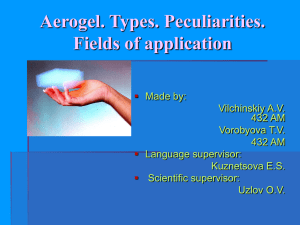

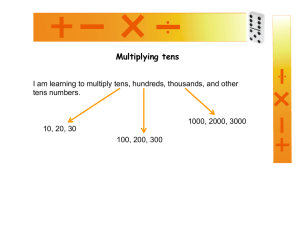



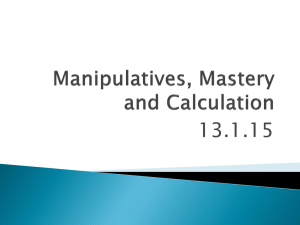
![Lesson 8_3–Synchronous Counters[1]](http://s2.studylib.net/store/data/005727557_1-25e5d6e99f500ad17373ec48380a1b3c-300x300.png)

